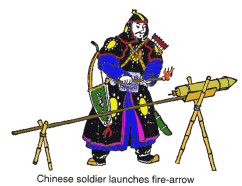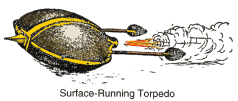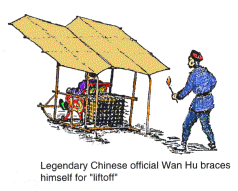 Rockets
were first used as actual weapons in the battle of Kai-fung-fu in 1232 A.D.
The Chinese attempted to repel Mongol invaders with barrages of fire arrows
and, possibly, gunpowder-launched grenades. The fire-arrows were a simple form
of a solid-propellant rocket. A tube, capped at one end, contained gunpowder.
The other end was left open and the tube was attached to a long stick. When
the powder was ignited, the rapid burning of the powder produced fire, smoke,
and gas that escaped through the open end and produced a thrust. The stick acted
as a simple guidance system that kept the rocket headed in one general direction
as it flew through the air. It is not clear how effective these arrows of flying
fire were. But one source reported that one grenade could incinerate a 2,000
square foot area.
Rockets
were first used as actual weapons in the battle of Kai-fung-fu in 1232 A.D.
The Chinese attempted to repel Mongol invaders with barrages of fire arrows
and, possibly, gunpowder-launched grenades. The fire-arrows were a simple form
of a solid-propellant rocket. A tube, capped at one end, contained gunpowder.
The other end was left open and the tube was attached to a long stick. When
the powder was ignited, the rapid burning of the powder produced fire, smoke,
and gas that escaped through the open end and produced a thrust. The stick acted
as a simple guidance system that kept the rocket headed in one general direction
as it flew through the air. It is not clear how effective these arrows of flying
fire were. But one source reported that one grenade could incinerate a 2,000
square foot area.Following the battle of Kai-Keng, the Mongols produced rockets of their own. During the 13th to the 15th centuries, the Mongols used rockets in their attacks on Japan and Baghdad and may have been responsible for the spread of rockets to Europe. In England, a monk named Roger Bacon worked on improved forms of gunpowder that greatly
 increased
the range of rockets. In France, Jean Froissart found that
more accurate flights could be achieved by launching rockets through tubes.
Froissart's idea was the forerunner of the modern bazooka. Joanes de
Fontana of Italy designed a surface-running rocket-powered torpedo
for setting enemy ships on fire.
increased
the range of rockets. In France, Jean Froissart found that
more accurate flights could be achieved by launching rockets through tubes.
Froissart's idea was the forerunner of the modern bazooka. Joanes de
Fontana of Italy designed a surface-running rocket-powered torpedo
for setting enemy ships on fire.By the 16th century rockets fell into a time of relative disuse as weapons of war, though they were still used extensively in fireworks displays. A German fireworks maker, Johann Schmidlap, invented the first "step rocket," a multi-staged vehicle for lifting fireworks to higher altitudes. A large rocket was ignited initially and carried one or more smaller rockets. When the large rocket burned out, the smaller rockets ignited and continued to a higher altitude before showering the sky with glowing cinders. Schmidlap's idea, known today as staging, is basic to all modern rocketry.
 On
the day of the flight, Wan-Hu sat in the chair and gave the command to light
the rockets. Forty-seven assistants, each armed with torches, rushed forward
to light the rockets. In a moment, there was a tremendous roar accompanied by
billowing clouds of smoke. When the smoke cleared, Wan-Hu and his flying chair
were gone. No one knows for sure what happened to Wan-Hu, but it is probable
that the event really did take place. Fire-arrows are still as apt to explode
as to fly!
On
the day of the flight, Wan-Hu sat in the chair and gave the command to light
the rockets. Forty-seven assistants, each armed with torches, rushed forward
to light the rockets. In a moment, there was a tremendous roar accompanied by
billowing clouds of smoke. When the smoke cleared, Wan-Hu and his flying chair
were gone. No one knows for sure what happened to Wan-Hu, but it is probable
that the event really did take place. Fire-arrows are still as apt to explode
as to fly!